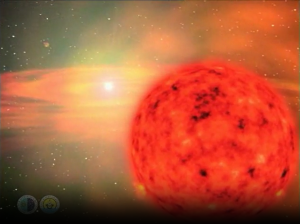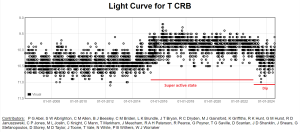2024 August 20
Preparing for the next eruption of the recurrent nova T Coronae Borealis!

T CrB is one of 10 known galactic recurrent novae and was observed in eruption in 1866 and 1946. The 80 year separation has led to much anticipation of a further eruption soon. However, eruptions of recurrent novae do not occur with specific regularity, so there is uncertainty about when exactly it will erupt. But erupt it will! At its peak it might reach magnitude 1.7, brighter than any other star in Corona Borealis. But it won’t be around long, just a few days before it fades below naked eye visibility.
Like all novae, T CrB is a binary system. In this case there is an M4 red giant star in a 227-day orbit round a planet-sized white dwarf. The two stars are 0.54 AU apart. Material is drawn from the red giant due to the strong gravitational field of the white dwarf. It accumulates in an accretion disk around the white dwarf. Some of the material gets funnelled down to the white dwarf’s surface, becomes compacted and heated, and eventually ignites in a spectacular thermonuclear explosion. We see the result as a sudden brightening of the star. Only a tiny fraction of the mass of the binary is lost in the eruption, so that with time the process can repeat itself. In fact, it is thought that all novae recur on some time scale, but for some it could be thousands of years.
When will the next eruption occur?
So the question of the moment is “when will T CrB erupt?” That question is hard to answer with any certainty. Prof. Bradley E. Schaefer (Department of Physics and Astronomy, Louisiana State University) has studied the long-term light curve of T CrB spanning 1842–2022. He notes that the two previous eruptions were identical, and he uses features in the light curve to predict when the next eruption might occur: 2024.4 ±0.3, i.e. February to September this year.
In early 2015, T CrB entered a “super active” state in which it brightened by about three-quarters of a magnitude and became bluer. Intriguingly, it entered a similar super active state in 1938, some 8 years before the eruption. Hence astronomers have been put on warning of an eruption soon. Schaefer points out that the end of this state in 1945 was a year before the eruption. This was followed by a dip 3 months before the eruption. This dip was noticed by the famous US amateur astronomer, Leslie Peltier, leading him to believe an eruption was imminent. This was a remarkable insight which turned out to be correct. Readers of Peltier’s charming autobiography, Starlight Nights, will be aware, though, that having monitored T CrB for over 25 years, when his alarm clock woke him on a cold February morning in 1946, he detected symptoms of a cold and returned to bed. That was of course the morning T CrB erupted again! The pre-eruption dip appears to be unique to T CrB and I have begun to refer to it as the “Peltier dip”.

Observations show that the super active phase ended in 2023 and that we are now in the pre-eruption dip. So clearly things are in transition in T CrB and it now appears that we are in the final run up to the next eruption. However, it should be remembered that although the last two outbursts were identical, it doesn’t mean that this one will be! In fact, the super active state this time round was not quite as bright as before the last eruption.
Prof. Schaefer has identified two earlier eruptions in the historical record: one in 1217 and another in 1787. Taking these four eruptions into account, he has estimated the interval between eruptions. Simply extending this sequence gives 2024.7 (~September 2024). In a recent webinar, Schafer said he is still convinced the eruption is imminent in the next few months.
Others have also made predictions. For example, Prof. Ulisse Munari (University of Padua) noted the interval between the last two outbursts was exactly 128 orbital revolutions, which, if the same were to happen this time round, would take it to 2025 November.
A call for observations: visual, digital and spectroscopic
There will be great kudos for anyone who discovers the eruption. On average, someone in the world observes T CrB every 6 mins. The last two eruptions were discovered by amateur astronomers (John Birmingham, in Ireland in 1866; A.S. Kamenchuk, Soviet Siberia, Frank Knight, England, and Michael Woodman, Wales, in 1946) and it would be wonderful if the next eruption were also discovered by an amateur.
Thus, vigilance is called for and observers are encouraged to keep a close eye on T CrB. Nightly visual and digital (CCD/CMOS) observations are requested to monitor the current fade. Comparison star charts of the field are available from the VSS website. At the time of writing, T CrB is around 10th magnitude, so a small telescope is required to see it.
The rise to maximum takes only a few hours. Therefore, frequent monitoring is called for. At its simplest, turning binoculars to the region might reveal the eruption first. Several people are also using the new generation of smart telescopes like the ZWO Seestar S50 to monitor for the eruption.
Time series photometry runs of around 2 hours to monitor flickering would also be useful. Exposures should be less than 30 seconds so that the rapid changes can be characterised, and with random errors <0.01 mag. Ideally a B filter should be used, otherwise V, but failing that unfiltered. Visual observers might also look out for flickering. Spectroscopy would also be useful to monitor the change in the H and He emission as the eruption approaches – and, of course, during the eruption.
Observers are requested to report their observations to the VSS databases. In the event of the eruption being detected (e.g., anything brighter than magnitude 7), please report to the BAA VSS Alert email system. An alternative is the BAA Forum, though this might result in a delay in the observation being picked up. From UK latitudes, observations are generally possible in the western evening sky until late November and in the morning sky after that. Observers are requested to make extra efforts during this period, thus avoiding a seasonal gap.
It is exciting to anticipate the appearance of a bright nova in our skies in the not-too-distant future. Although T CrB reaches magnitude 1.7, this is a fast nova and it fades by 3 magnitudes in ~5 days so we still have to hope for good weather. It’s also worth noting that observations should continue after the eruption as a secondary eruption is anticipated about 85 days after the first. But it won’t be nearly as bright: 8th magnitude in 1866 and 1946. This secondary eruption will be much longer at ~90 days.
| The British Astronomical Association supports amateur astronomers around the UK and the rest of the world. Find out more about the BAA or join us. |
